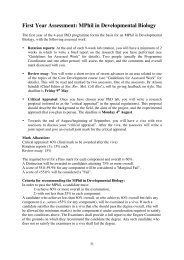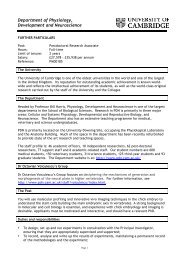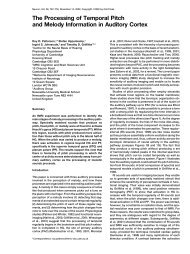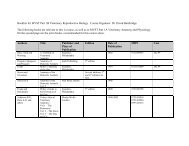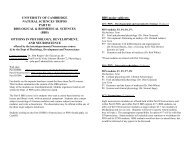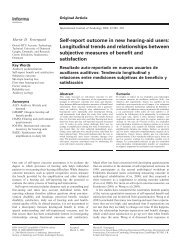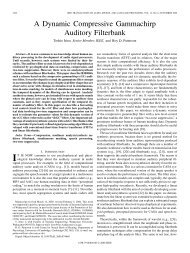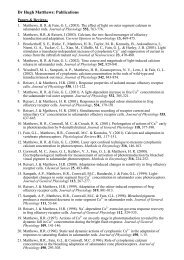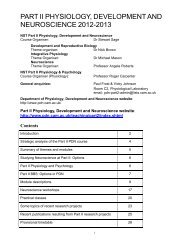FRIDAY MORNING, 20 MAY 2005 REGENCY E, 8:30 A.M. TO 12:00 ...
FRIDAY MORNING, 20 MAY 2005 REGENCY E, 8:30 A.M. TO 12:00 ...
FRIDAY MORNING, 20 MAY 2005 REGENCY E, 8:30 A.M. TO 12:00 ...
You also want an ePaper? Increase the reach of your titles
YUMPU automatically turns print PDFs into web optimized ePapers that Google loves.
<strong>FRIDAY</strong> <strong>MORNING</strong>, <strong>20</strong> <strong>MAY</strong> <strong>20</strong>05<br />
PLAZA C, 8:50 <strong>TO</strong> 11:<strong>30</strong> A.M.<br />
Session 5aAB<br />
Animal Bioacoustics and ASA Committee on Standards: Behavioral Audiometric Methods in Animal<br />
Bioacoustics: The Search for Standards I<br />
Edward J. Walsh, Cochair<br />
Boys Town National Research Hospital, Omaha, NB 68131<br />
Ann. E. Bowles, Cochair<br />
Hubbs-Sea World Research Inst., 2595 Ingraham St., San Diego, CA 92109<br />
Chair’s Introduction—8:50<br />
Invited Papers<br />
9:<strong>00</strong><br />
5aAB1. Common hearing functions among mammals and birds. Richard R. Fay Parmly Hearing Inst., Loyola Univ. Chicago,<br />
6525 N. Sheridan Rd., Chicago, IL 60626, rfay@luc.edu<br />
Among many mammals and birds, frequency-place cochlear maps have a similar form and differ primarily with respect to the<br />
length of the cochlea or basilar papilla, and with respect to the frequency range of hearing. This is remarkable, especially given the<br />
differences in anatomical organization and evolutionary history between mammals and birds. This is a striking example of convergent<br />
or parallel evolution. With few exceptions, the cochleae of mammals and birds are indeed scale models of one another. One of the<br />
primary functions of the frequency-place map is in frequency analysis. Whether this function is defined by frequency discrimination<br />
thresholds, critical masking ratios, critical bands or auditory filters in general, frequency analytic performance, behaviorally-defined,<br />
can be laid out on the basilar membrane and a critical basilar membrane distance can be associated with a given performance criterion.<br />
In general, these critical distances differ according to the function e.g., frequency delta Fs versus critical bandwidths, but are<br />
remarkably similar functions of frequency within and between species they tend to be constant. It seems likely that evolution has<br />
selected the consequences of frequency analytic mechanisms for perception rather than the mechanisms themselves. Work supported<br />
by NIH.<br />
9:<strong>20</strong><br />
5aAB2. How do you know what an animal can hear? Henry E. Heffner Dept. of Psych., Univ. of Toledo, Toledo, OH 43606<br />
The comparative study of hearing is based on the ability to obtain valid behavioral measures of hearing in different species. This<br />
requires careful generation and measurement of sound, a behavioral task and reinforcer appropriate for the species, and a comparable<br />
definition of threshold. For audiograms, it is important to generate artifact-free pure tones and test with the animal’s head fixed in a<br />
free-field sound field. For sound localization, a two-point discrimination with the animals head fixed in the sound field is commonly<br />
used. For all discriminations, it is important to obtain data for stimuli that are below threshold to ensure that an animal is not using<br />
extraneous cues. Descriptions of techniques should be sufficiently detailed to allow other researchers to replicate them; new techniques<br />
can be calibrated by replicating the results of others. Behavioral procedures that work well with one species may not elicit<br />
optimal performance from others. Although performance should be corrected for false positives, signal detection measures are difficult<br />
to interpret and cannot compensate for the failure to keep an animal under stimulus control. In general, valid results are obtained by<br />
following good scientific practice.<br />
9:40<br />
5aAB3. The critical band and the critical ratio. William A. Yost and William Shofner Parmly Hearing Inst., Loyola Univ.<br />
Chicago, 6525 N. Sheridan Rd., Chicago, IL 60626<br />
The critical band is arguably one of the most important psychophysical descriptors of auditory function. The critical ratio is often<br />
used in animal psychophysical research to estimate critical bandwidth because it is easier to obtain than estimates of critical bandwidth.<br />
However, in most cases the underlying assumptions required to use the critical ratio as an estimate of critical bandwidth are<br />
rarely met. The critical bandwidths for chinchilla and guinea pigs are similar to those obtained for human subjects, while the critical<br />
ratios are considerably higher, an observation that violates the use of the critical ratio as an estimate of critical bandwidth. This paper<br />
will describe the assumptions necessary for the critical ratio to estimate critical bandwidth. We will describe data on critical bands and<br />
critical ratios for chinchilla and guinea pigs, and we will provide evidence that the chinchilla appears to be a wideband processor of<br />
the signal in critical-ratio experiments. The inability of the chinchilla to process the signal in its narrow critical band in the criticalratio<br />
psychophysical procedure leads to the large critical ratios. We recommend that the critical ratio not be used to estimate critical<br />
bandwidth. Work supported by NIDCD grants to Dr. Yost and to Dr. Shofner.<br />
2582 J. Acoust. Soc. Am., Vol. 117, No. 4, Pt. 2, April <strong>20</strong>05 149th Meeting: Acoustical Society of America 2582



